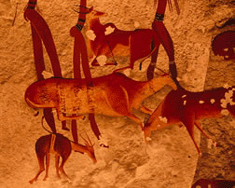 |
SA hosts World Heritage meet
4 July 2005
For the first time since the World Heritage Committee of the United Nations Educational, Scientific and Cultural Organisation (Unesco) was formed in 1972, its annual convention will be held in sub-Saharan Africa.
Seven hundred delegates from 180 countries are expected to attend the committee's 29th session at the Durban International Convention Centre from 10 to 17 July.
The meeting will decide on new sites to be included in the World Heritage List, as well as policy and funding matters.
World heritage in SA - Did you know that Table Mountain has more plant species than the British Isles? Or that the Drakensberg has both the highest peak in Africa after
Kilimanjaro and the continent's richest concentration of rock art? 
|
|
South Africa has six World Heritage sites. A seventh site and extensions to existing ones will be nominated at the Durban meeting.
The current chair of Unesco's World Heritage Committee is Themba Wakashe, the deputy director-general of heritage, archive and library services at South Africa's Department of Arts and Culture.
Six for South Africa
Internationally, there are over 788 World Heritage sites in 134 countries. Africa has 63 sites, while South Africa has six - three cultural, two natural and one mixed:
- Robben Island in the Western Cape, inscribed on the World Heritage List in 1999 as a cultural site that symbolises "the triumph of the human spirit, of freedom, and of democracy over oppression".
- The
Cradle of Humankind, comprising the fossil hominid sites of Sterkfontein, Swartkrans, Kromdraai and environs in Gauteng and North West, inscribed as a cultural site in 1999.
- The Greater St Lucia Wetland Park in KwaZulu-Natal, inscribed in 1999 as a natural site with "exceptional biodiversity".
- The uKhahlamba Drakensburg Park in KwaZulu-Natal, inscribed in 2000 as a mixed cultural-natural site with "exceptional natural beauty in its soaring basaltic buttresses, incisive dramatic cutbacks and golden sandstone ramparts".
- The Mapungubwe Cultural Landscape in Limpopo, inscribed as a cultural site in 2003 and described as "a remarkably complete testimony to the growth and subsequent decline of the Mapungubwe state … the largest kingdom in the African sub-continent".
- The Cape Floral Region of the Western Cape, inscribed as a natural site in 2004 and identified as "one of the world's 18 biodiversity hot-spots".
The Unesco World Heritage
Committee describes all six sites as places of "outstanding universal value".
World's biggest meteor crater
Two billion years ago a meteorite 10km wide hit the earth in the Free State, creating the largest and oldest impact crater in the world. 
|
|
A new site, the Vredefort Dome in Free State, and extensions to existing sites - Makapans Valley in Limpopo and Taung Skull in North West - are to be nominated at the Durban meeting.
Vredefort Dome is an ancient extraterrestrial impact site southwest of Johannesburg. At 2 000 years old it is the
world's most ancient meteorite impact scar and the third-largest, measuring 140km wide. It is a relic of a remarkable moment in the earth's history.
Makapans Valley has an unbroken record of occupation by ancestral humankind, extending from the proto-human Australopithecine times of some 3.5-million years ago through the Stone Ages to the present. The record is preserved as fossil teeth and bones as well as stone tools and other artefacts.
The committee
The World Heritage Committee consists of representatives from 21 of the states that are party to the World Heritage Convention, which South Africa ratified in 1997. The convention aims to protect world cultural and natural heritage.
The committee is currently made up of Argentina, Benin, Chile, China, Colombia, Egypt, India, Japan, Kuwait, Lebanon, Lithuania, Netherlands, New Zealand, Nigeria, Norway, Oman, Portugal, Russian Federation, Saint Lucia, South Africa (chair) and the UK.
The committee's functions are to:
- Identify cultural and natural properties of outstanding universal value that are to be protected, and add these to the World Heritage List.
- Monitor the state of conservation of properties inscribed on the list.
- Decide which properties included in the World Heritage List are to be added to or removed from the List of World Heritage in Danger.
- Decide whether a site should be removed from the World Heritage List.
- Assess requests for international assistance from the World Heritage Fund.
During the eight-day meeting, delegates will have the opportunity to visit the Greater St Lucia Wetland Park and the uKhahlamba Drakensberg Park.
SouthAfrica.info reporter


|  |
 |

 |
 |
 |
 |
Rock art by San (Bushmen) in the central Drakensberg. The uKhahlamba Drakensberg Park, a mixed cultural-natural site, is one of South Africa's seven World Heritage sites (Photo: SA Tourism) |
 |
|


















